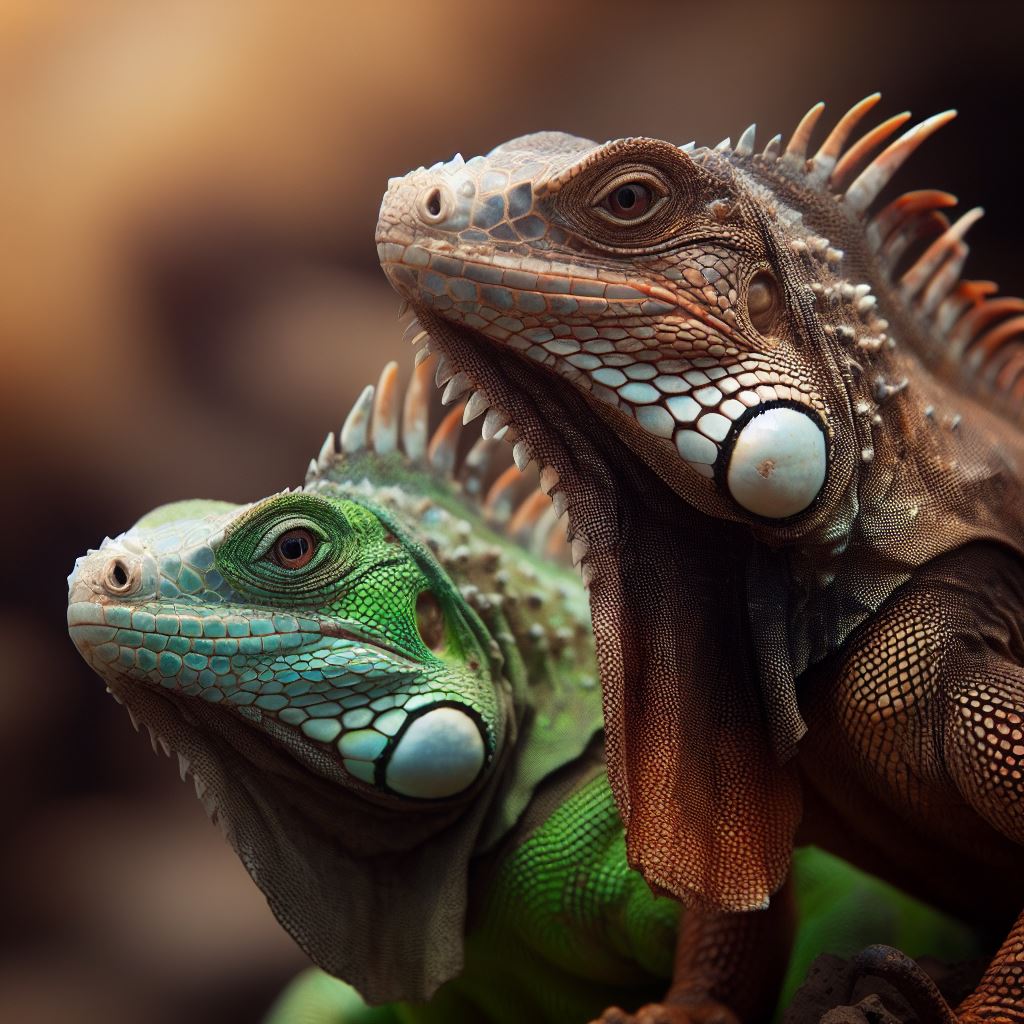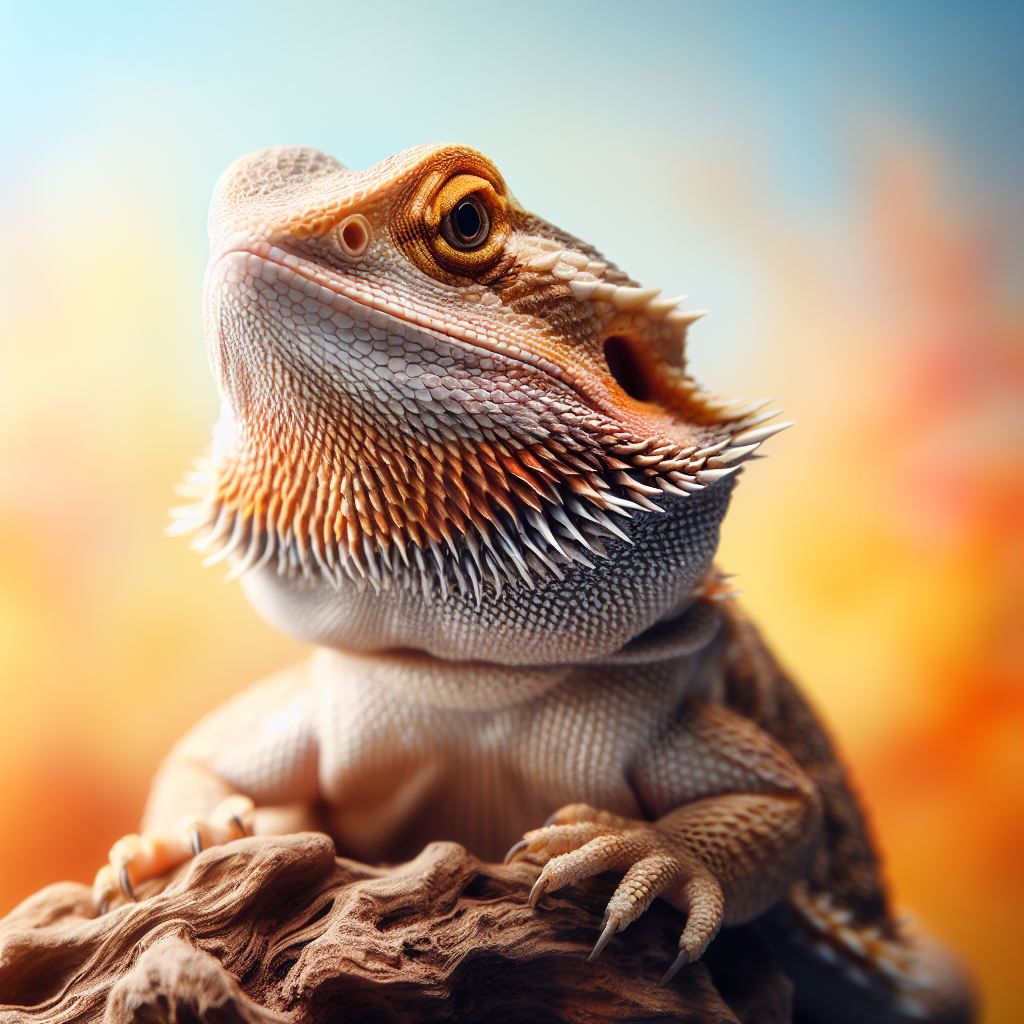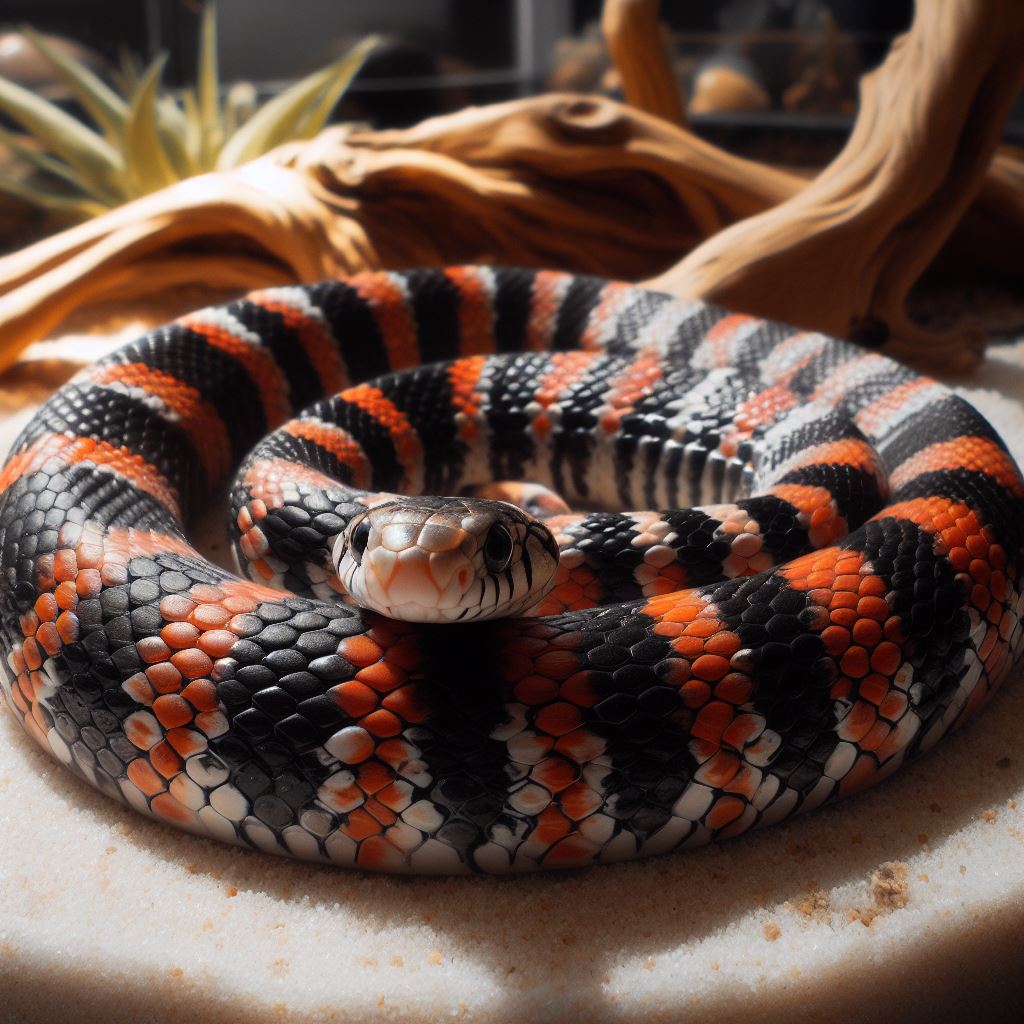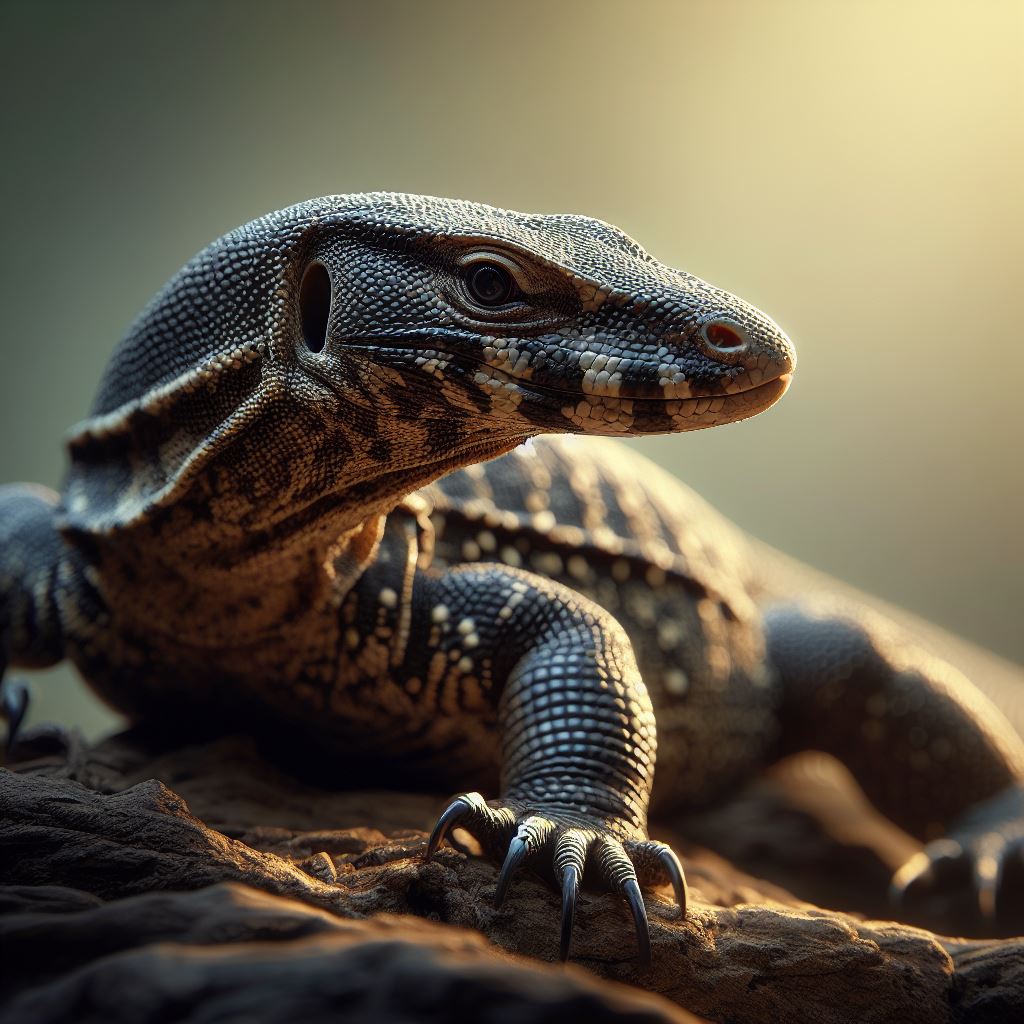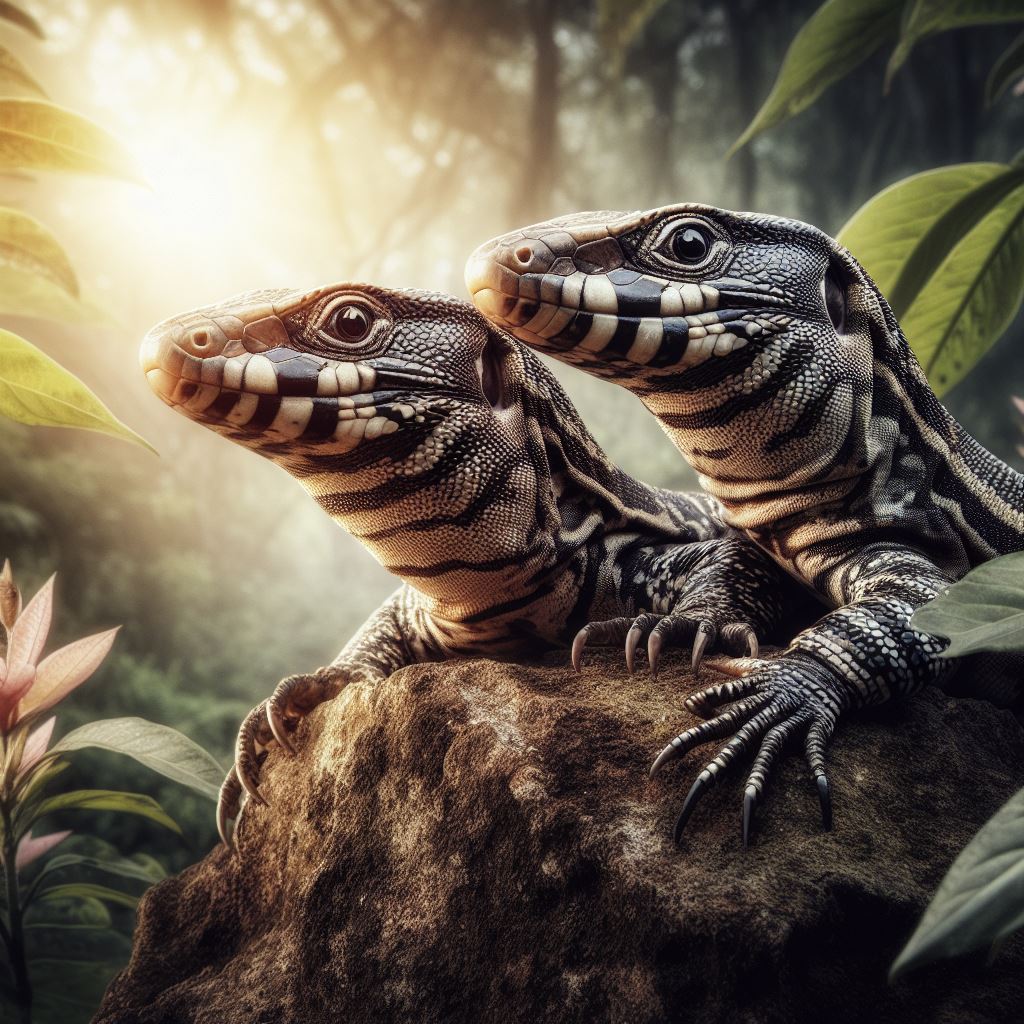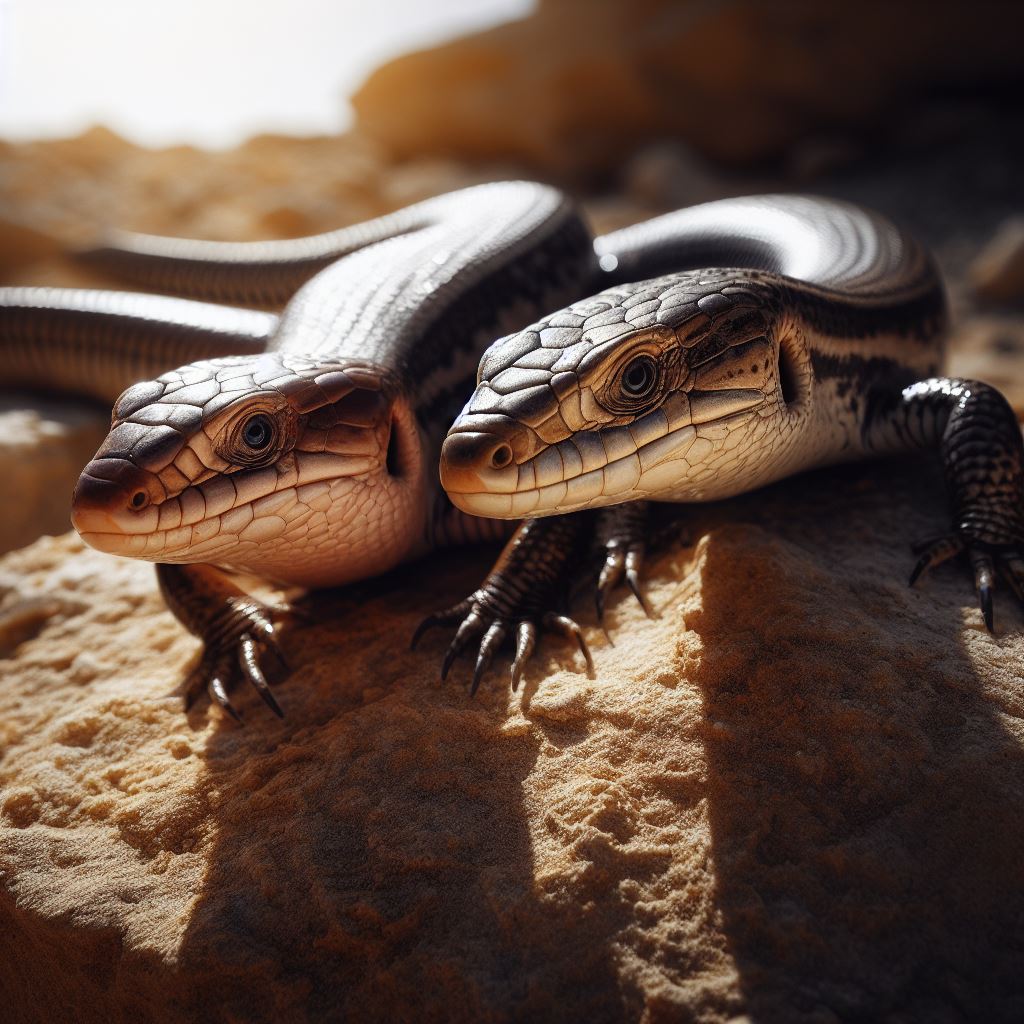Dive into the vibrant world of Iguanas, the charismatic reptiles that have entranced pet enthusiasts worldwide. This all-encompassing guide delves into the secrets of Iguanas, exploring their intriguing biology, diverse species, and the crucial aspects of caring for them as beloved pets. Whether you’re a seasoned herpetologist or a novice reptile enthusiast, this guide serves as your passport to unravel the enigmatic charm of Iguanas.
Iguanas: Nature’s Marvels
Anatomy and Unique Features of Iguanas
Anatomy:
- Body Structure: Iguanas have elongated bodies, typically with a robust build. They are well-adapted for climbing trees and are usually arboreal.
- Tail: Iguanas possess long, muscular tails that serve multiple purposes, including balance, defense, and communication. Some iguanas can regenerate their tails if they are lost.
- Skin: Their skin is covered in rough, scaly plates, providing protection against the environment. Iguanas can change skin color, helping them regulate body temperature and communicate with other iguanas.
- Limbs: They have well-developed limbs with sharp claws, aiding in climbing and grasping objects.
- Head: Iguanas have a relatively short snout and keen eyesight, allowing them to detect movement and potential threats.
Unique Features:
- Herbivorous Diet: Iguanas are primarily herbivores, consuming a diet consisting mainly of leaves, flowers, and fruits. Their teeth are adapted for cutting and grinding plant material.
- Thermoregulation: Iguanas are ectothermic, relying on external sources of heat to regulate their body temperature. They bask in the sun to warm up and seek shade or water to cool down.
- Tail Autotomy: Iguanas can voluntarily shed their tails as a defense mechanism. The detached tail can distract predators, allowing the iguana to escape. The tail regrows, although it might be shorter and different in appearance.
- Communication: Iguanas use various forms of body language, including head bobbing and dewlap extensions, to communicate with each other. These behaviors are often used in mating rituals or to establish territory.
- Oviparous Reproduction: Female iguanas lay eggs in nests dug in the soil. After an incubation period, the hatchlings emerge fully formed.
- Aquatic Adaptations: While most iguanas are terrestrial or arboreal, some species, like the marine iguana found in the Galápagos Islands, are excellent swimmers and feed on marine algae.
These unique characteristics make iguanas intriguing and diverse members of the lizard family.
The Family Iguanidae: Exploring Iguanas’ Taxonomy and Diversity
The Iguanidae family encompasses a diverse group of lizards, commonly known as iguanas. This family is known for its wide range of species, each with unique characteristics and habitats. Here’s an exploration of the taxonomy and diversity within the Iguanidae family:
Taxonomy:
- Kingdom: Animalia
- Phylum: Chordata
- Class: Reptilia
- Order: Squamata (scaled reptiles)
- Suborder: Iguania
Diversity:
Genera:
- Iguana: The most well-known genus, including the iconic Green Iguana (Iguana iguana) found in Central and South America.
- Ctenosaura: Often called spinytail iguanas, they are characterized by their spiny tails. Species within this genus are found in North, Central, and South America.
- Anolis: Also known as anoles, these are small to medium-sized lizards found mainly in the Americas. They are known for their adaptability and are arboreal in nature.
- Phrynosoma: Horned lizards, native to North and Central America, known for their distinct, flattened bodies and horns on their heads.
- Dipsosaurus: Desert iguanas found in the southwestern United States and Mexico, adapted to arid environments.
Geographic Diversity:
- Tropical Iguanas: Found in Central and South America, these iguanas are often brightly colored and arboreal, living in rainforests and coastal areas.
- Desert Iguanas: Adapted to desert environments in North and Central America, such as the Dipsosaurus genus, they have specialized features for conserving water.
- Island Endemics: Some iguanas, like the Galápagos marine iguana, are unique to specific islands and have adapted to their distinct habitats.
Popular Iguana Species
Several iguana species are popular among reptile enthusiasts due to their unique appearances and relatively manageable care requirements. Here are a few of the most popular iguana pet species:
Green Iguana (Iguana iguana):
The Green Iguana is one of the most well-known and widely kept iguana species. They are appreciated for their vibrant green coloration and can make captivating pets, although they require large enclosures and specific environmental conditions.
Blue Iguana (Cyclura lewisi):
The Blue Iguana, native to the Grand Cayman Island, is critically endangered in the wild. They are named for their blue-gray coloration and are kept in captivity as part of conservation efforts.
Red Iguana (Iguana iguana rhinolopha):
Red Iguanas are a color morph of the Green Iguana, featuring various shades of red, orange, or even purple. These color variations make them highly sought after among collectors.
Mexican Spiny-Tailed Iguana (Ctenosaura pectinata):
These iguanas are known for their spiky tails and are relatively hardy in captivity. They are active and enjoy basking, making them interesting pets for enthusiasts.
Fiji Banded Iguana (Brachylophus fasciatus):
Native to Fiji, these iguanas are recognized for their vivid blue and green stripes. They are considered a threatened species and are kept in captivity by reptile enthusiasts and conservationists.
Black Spiny-Tailed Iguana (Ctenosaura similis):
Found in Central America and Mexico, this iguana species is known for its black coloration and spiny tail. They are relatively hardy in captivity and are appreciated for their unique appearance.
Lesser Antillean Iguana (Iguana delicatissima):
Native to the Lesser Antilles in the Caribbean, this iguana species is known for its small size and vibrant coloration. They are critically endangered in the wild and are bred in captivity for conservation purposes.
It’s important to note that while these iguanas are popular, they require proper care, including spacious enclosures, appropriate lighting, temperature, and a balanced diet. Potential iguana owners should thoroughly research the specific needs of the species they plan to keep before acquiring one as a pet.
Iguana Care: Creating a Home
Enclosure Design: Mimicking Natural Habitats
Designing an enclosure that mirrors their natural habitat is vital for Iguana health and happiness. Incorporating climbing structures, basking platforms, and hiding spots offers a stimulating environment. UVB lighting, essential for their calcium metabolism, and heat sources create temperature gradients, allowing Iguanas to regulate their body temperature. Natural substrates, such as soil and mulch, facilitate digging behaviors, enhancing their overall well-being.
Size and Space:
- Iguanas need spacious enclosures. For juvenile iguanas, a 40-gallon tank is a starting point, but they will need larger enclosures as they grow.
- Adult iguanas require large enclosures, preferably custom-built, with dimensions at least 6 feet in height, 6 feet in length, and 3 feet in width.
- Vertical space is essential as iguanas are arboreal and need height for climbing.
Substrate:
- Use a substrate that allows for digging and retains moisture. Cypress mulch, coconut coir, or a mixture of organic soil and sand can be suitable substrates.
Climbing Structures:
- Provide sturdy branches, logs, and platforms for climbing. Iguanas love to climb and explore their surroundings.
Basking Spot:
- Install a basking spot with a heat lamp to mimic the sun. The basking spot should reach temperatures between 90-95°F (32-35°C).
- Use full-spectrum UVB lights to ensure proper calcium metabolism. Replace these bulbs every 6-12 months, as their UVB output diminishes over time.
Temperature Gradient:
- Maintain a temperature gradient in the enclosure. The cooler side should be around 75-85°F (24-29°C). Use heat emitters or ceramic heat lamps during the night to prevent temperatures from dropping too low.
Humidity:
- Iguanas need a relatively high humidity level, especially if they are not provided with a water source in the enclosure. Mist the enclosure regularly to maintain humidity levels between 60-70%.
Plants and Hideouts:
- Use live plants (non-toxic) to provide a natural feel and improve air quality.
- Create hiding spots with hollow logs or commercially available reptile hides.
Diet and Water:
- Provide a water dish for drinking and soaking. Ensure it’s large enough for the iguana to soak in comfortably.
- Include a variety of leafy greens, vegetables, and fruits in their diet. Research their specific dietary needs for proper nutrition.
Maintenance:
- Regularly clean and disinfect the enclosure to prevent the growth of harmful bacteria.
- Provide a separate enclosure for feeding to prevent substrate ingestion.
Enrichment:
- Offer mental stimulation through puzzle feeders and objects they can interact with. Rearrange the enclosure periodically to provide a change in the environment.
By considering these factors and regularly monitoring your iguana’s behavior and health, you can create an enclosure that not only resembles their natural habitat but also promotes their physical and mental well-being.
Dietary Needs: Nutrition and Feeding Practices
Iguanas have specific dietary needs that are essential for their overall health and well-being. Providing a balanced and nutritious diet is crucial to ensure they receive the necessary vitamins and minerals. Here are some guidelines for the dietary needs, nutrition, and feeding practices of iguanas:
Primary Diet:
- Vegetables: Offer a variety of leafy greens such as collard greens, mustard greens, turnip greens, kale, and dandelion greens. These greens are high in calcium and other essential nutrients.
- Fruits: Provide fruits like papaya, mango, figs, kiwi, and berries. Give them Fruits in moderation due to their high sugar content.
- Vegetables: Include vegetables like squash, bell peppers, and carrots. These provide necessary vitamins and minerals.
- Avoid High Oxalate Foods: Avoid high in oxalate foods, such as spinach and beet greens, feeding them sparingly as they can interfere with calcium absorption.
Supplementation:
- Calcium and Vitamin D3: Dust vegetables with a calcium supplement containing vitamin D3 a few times a week. This helps prevent metabolic bone disease.
- Multivitamins: Use reptile-specific multivitamin supplements once or twice a month to ensure they receive a variety of essential nutrients.
Feeding Practices:
- Fresh Food: Provide fresh, pesticide-free food. Wash all fruits and vegetables thoroughly before feeding to remove pesticides and contaminants.
- Variety: Offer a variety of foods to encourage a well-rounded diet. Iguanas can be picky eaters, so trying different foods can help find their preferences.
- Frequency: Feed juvenile iguanas daily and adult iguanas every other day. However, ensure they have access to fresh water at all times.
- Avoid Animal Proteins: Iguanas are primarily herbivores. Avoid feeding them animal proteins regularly.
Water Intake:
- Soaking: Provide a shallow dish for soaking. Iguanas absorb water through their skin, so soaking helps maintain hydration.
- Drinking: While iguanas may not drink water directly, having a water dish in the enclosure is essential. They might soak in it and drink during soaking.
Monitoring and Adjusting:
- Observe Behavior: Monitor their eating habits and behavior. Changes in appetite or stool consistency might indicate health issues.
- Consult a Veterinarian: If you’re uncertain about your iguana’s diet or health, consult a reptile veterinarian for guidance.
By adhering to these dietary guidelines and observing your iguana’s behavior, you can ensure they receive the nutrition they need for a healthy and fulfilling life. Remember that each iguana might have specific dietary preferences, so being attentive to their individual needs is crucial.
Iguana Behavior: Understanding and Interaction
Iguanas exhibit intricate social behaviors within their colonies, showcasing hierarchical structures and communication methods. Understanding their body language, including dewlap displays and tail movements, provides insights into their emotions and intentions. Observing their interactions fosters a deeper connection, allowing for meaningful engagement and mutual understanding.
Building trust with Iguanas involves patience, respect, and gentle handling. Allowing them to initiate contact and respecting their boundaries is essential. Gradual acclimation to human presence, coupled with positive reinforcement techniques, enhances their confidence. Handling sessions should be brief initially, gradually increasing in duration. A stress-free environment and consistent, respectful interaction transform wary Iguanas into relaxed, confident companions.
Health Care and Enrichment
Monitoring your iguana’s health is essential to ensure they lead a happy and comfortable life. Regular observation and prompt action can prevent or address common health issues. Here’s a guide to help you monitor your iguana’s health and recognize potential problems:
Health Monitoring:
- Behavioral Changes: Watch for changes in eating habits, activity levels, and behavior. Any sudden shifts could indicate an underlying issue.
- Body Condition: Regularly check their body condition. A healthy iguana should have a good body weight, a well-rounded tail base, and clear eyes.
- Shedding: Iguanas shed their skin. Ensure they shed completely without any retained shed, especially around the toes and tail, which can cause circulation problems.
- Hydration: Monitor their water intake. Dehydration can be a concern, especially if they are not soaking regularly.
- Defecation: Pay attention to their droppings. Changes in color, consistency, or frequency can indicate digestive issues.
Common Health Issues:
- Metabolic Bone Disease (MBD): Caused by calcium and/or vitamin D3 deficiency, MBD results in weak bones, deformities, and difficulty in movement.
- Respiratory Infections: Symptoms include wheezing, labored breathing, or nasal discharge. Respiratory infections can result from inadequate temperature or humidity levels.
- Digestive Problems: Diarrhea, constipation, or lack of appetite could be signs of gastrointestinal issues. Poor diet or improper husbandry might be the cause.
- Parasites: Internal and external parasites, such as mites and worms, can affect iguanas. Regular fecal examinations by a veterinarian can detect these issues.
- Mouth Rot (Stomatitis): Inflammation and infection in the mouth, often caused by poor oral hygiene or injuries, can lead to mouth rot.
- Egg Binding (Females): Female iguanas can experience difficulties laying eggs. If you notice signs of discomfort, restlessness, or swelling around the abdomen, consult a vet.
- External Injuries: Treat Wounds, cuts, or abrasions should promptly to prevent infections.
Veterinary Care:
- Regular Check-ups: Schedule regular veterinary check-ups, even if your iguana appears healthy, to catch potential issues early.
- Specialized Vet: Consult a reptile-experienced veterinarian for proper care. Regular vets might not have the expertise required for exotic reptiles.
- Quarantine New Additions: If you introduce new iguanas to your collection, quarantine them to prevent the spread of potential diseases.
Remember, proactive care and a keen eye for changes in behavior and appearance are vital in keeping your iguana healthy. Providing a suitable habitat, balanced diet, and regular veterinary attention will go a long way in ensuring your pet’s well-being
Conclusion
Iguanas, with their diverse species and intriguing behaviors, stand as captivating companions for those enthralled by the reptilian world. By comprehending their natural behaviors, habitat requirements, and dietary intricacies, you can create an environment where these extraordinary creatures flourish. Responsible pet ownership is not merely a choice but a commitment—one that ensures the flourishing existence of Iguanas and, indeed, all reptile species. Embrace the opportunity to welcome these majestic beings into your life and embark on a fulfilling journey of companionship and conservation.

